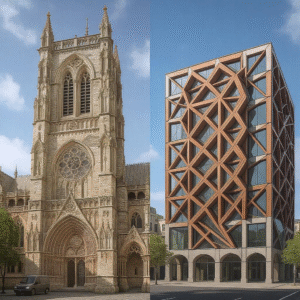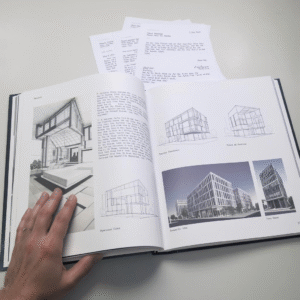The first time I walked through the Royal Institute of British Architects, I felt like I’d stumbled into a secret society. Students huddled over massive drafting tables, their fingers stained with ink and coffee, muttering about cantilevers and thermal bridges. That moment crystallized something I’d been thinking about for months: studying architecture courses UK isn’t just about getting a degree—it’s about joining a centuries-old conversation about how we shape the world around us.
But here’s the thing that caught me off guard. Everyone talks about the prestige, the history, the stunning campuses. What they don’t mention? The sheer complexity of navigating architecture courses UK programs when you’re coming from outside the system. It’s like trying to decode architectural blueprints written in three different languages.
Decoding Britain’s Peculiar Three-Act Architecture Drama
British architecture education operates on a peculiar three-part system that would make Kafka proud. Part 1 gets you a bachelor’s degree. Part 2 requires a master’s plus work experience. Part 3? That’s where things get interesting—professional practice and final qualification. It sounds bureaucratic, but there’s genius in this madness.
This staged approach means you’re not just memorizing load calculations (though you’ll do plenty of that). You’re actually building buildings, working with real clients, making real mistakes. I’ve seen students emerge from architecture courses UK programs with portfolios that would make seasoned professionals weep with envy.
The strangest part? Some universities let you jump between different parts of the process. Cambridge might seduce you with its medieval courtyards, but what if Edinburgh’s sustainable design focus suddenly calls to you during your placement year? The system’s flexibility is both terrifying and liberating.
Gothic Towers and Robot Labs: Where Ancient Meets Artificial
Stone Corridors with Space-Age Dreams
Oxford and Cambridge don’t just teach architecture—they practically invented the concept of architectural education. Walking through these institutions feels like time travel. One minute you’re sketching Roman basilicas, the next you’re 3D printing parametric facades. The contrast is jarring, intentionally so.
But here’s what surprised me most about these venerable institutions: they’re not museum pieces. Cambridge’s architecture department recently collaborated with NASA on lunar habitat design. Oxford students are pioneering bio-responsive building materials. The history isn’t holding them back; it’s launching them forward.

London’s Beautiful Chaos Factory
Students pursuing architecture courses UK often gravitate toward London, and honestly, I understand why. The Bartlett at UCL has this reputation for producing architectural rebels—the kind of graduates who show up to job interviews with installations instead of portfolios. Their experimental approach either thrills or terrifies traditional practices. Usually both.
The Architectural Association operates almost like an architectural commune. Students from 80+ countries converge in Bedford Square, creating projects that blur the line between architecture and art. It’s expensive, it’s intense, and it produces graduates who think sideways.
| University | Notable Strength | Approximate Annual Fees | Unique Feature |
|---|---|---|---|
| University of Cambridge | Historical preservation + innovation | £33,000-£37,000 | Medieval buildings as living laboratories |
| The Bartlett (UCL) | Experimental design | £31,200 | Robot-assisted construction lab |
| Architectural Association | Avant-garde theory | £29,000-£34,000 | No formal admission requirements |
| University of Edinburgh | Sustainable design | £28,950 | Scotland’s building traditions integration |
| University of Bath | Integrated engineering approach | £26,800 | Year in professional practice mandatory |
Beyond London: The Unsung Heroes Building Tomorrow
Sheffield’s architecture program occupies this gorgeous brutalist building that students either love or hate (there’s no middle ground). What’s fascinating is how the building itself becomes part of the curriculum. You’re not just studying spatial relationships—you’re living them. The architecture courses UK landscape wouldn’t be complete without Sheffield’s gritty, practical approach.
Manchester produces architects with grit. The industrial heritage seeps into everything, from material choices to urban planning approaches. Students graduate understanding that architecture isn’t just about pretty buildings—it’s about solving complex social problems in post-industrial cities.
Cardiff’s Welsh School of Architecture has quietly become a powerhouse in environmental design. Their students are pioneering techniques for retrofitting Victorian terraces, turning energy-hungry relics into zero-carbon homes. It’s unglamorous work that might just save the planet.

When Your Bank Account Meets Your Dreams (Spoiler: It’s Complicated)
International students exploring architecture courses UK programs need to brace themselves for sticker shock. We’re talking £25,000-£40,000 annually, plus living expenses that can easily add another £15,000-£20,000. London? Double that living cost estimate.
But here’s what the marketing brochures won’t tell you: architecture students get resourceful fast. I know graduates who funded their degrees through architectural photography, 3D visualization freelancing, even designing escape rooms. The skills you learn—spatial thinking, technical drawing, project management—they’re surprisingly marketable.
Scholarships exist, but they’re competitive. The Commonwealth Scholarship Commission offers full funding for exceptional candidates from certain countries. Private foundations like the Leverhulme Trust occasionally support international architecture students. But honestly? Most people I know cobbled together funding from multiple sources.
This is where organizations like GCRD Hub prove invaluable. Their tailored academic placement and scholarship support can help navigate the byzantine world of UK education funding. Sometimes having someone who understands the system makes the difference between getting accepted and actually being able to afford it.

Surviving the Portfolio Olympics and Personal Statement Torture
Portfolio preparation for promising architecture courses UK programs is an art form unto itself. British admissions committees want to see process, not just pretty pictures. They want to understand how you think, how you solve problems, how you iterate on ideas.

I’ve seen stunning portfolios rejected because they showed only final products. Conversely, I’ve seen rough, sketchy portfolios that got students into top programs because they demonstrated genuine intellectual curiosity and design thinking.
The personal statement is where many international students stumble. British admissions tutors can spot generic statements from orbit. They want specificity: Why this program? Why this approach to architecture? What unique perspective are you bringing to architecture courses UK?
⚠️ Warning: The Portfolio Trap Don’t make your portfolio a greatest hits album. Admissions committees can tell when you’re trying too hard to impress rather than communicate your thinking process.
| Application Component | Weight | What They’re Really Looking For |
|---|---|---|
| Portfolio | 60% | Design process + creative problem-solving |
| Personal Statement | 25% | Genuine passion + specific program fit |
| Academic Qualifications | 10% | Minimum threshold (varies by program) |
| Interview Performance | 5% | Communication skills + cultural fit |
Living on Coffee Fumes and Creative Adrenaline
The studio culture in top architecture courses UK programs is intense, borderline obsessive. Students practically live in their studios during major projects. It’s common to find people sleeping under their drafting tables during final reviews. (I may have done this more than once.)
This intensity creates bonds that last decades. Your studio mates become your chosen family, the people who understand why you care so deeply about the angle of a single beam or the texture of a wall surface. But it can also be isolating if you’re not prepared for the all-consuming nature of architectural education.
Mental health support varies dramatically between institutions. Some universities have caught up to the reality that architecture students face unique pressures. Others… haven’t. Ask about counseling services, peer support networks, and workload management before committing to architecture courses UK programs.
💡 Insider Tip: The 3 AM Test If you’re still excited about your design project at 3 AM after working on it for 12 hours straight, you might have found your calling. If you’re questioning your life choices, that’s also totally normal.
After the Degree: Welcome to Architecture’s Wild West
Here’s the uncomfortable truth about completing architecture courses UK programs: graduation doesn’t guarantee a job. The profession is notoriously competitive, salaries start low, and the path to chartered status is long and arduous.
But the graduates I know who’ve thrived share certain characteristics:
- They’re adaptable, comfortable with ambiguity
- They think systemically about complex problems
- They communicate design ideas across different audiences
- They embrace technology while respecting craft traditions
These skills transfer well beyond traditional architecture practice. Some become urban planners, reshaping cities for climate resilience. Others move into tech, designing virtual environments or user experiences. A surprising number become entrepreneurs, starting practices that blur the boundaries between architecture, art, and social activism.
Your Personal Architecture Manifesto: Making the Choice
Choosing among architecture courses UK programs ultimately comes down to finding the right cultural and intellectual fit. The prestige rankings matter less than finding a place where your particular way of thinking about space and place will be nurtured and challenged.
Visit if you can. Attend lectures, talk to current students, spend time in the studios. Each program has a distinct personality, and that personality needs to resonate with yours. Does the Bartlett’s experimental chaos excite or overwhelm you? Do Cambridge’s ancient stones inspire or intimidate?
Consider seeking guidance from specialists in educational placement. GCRD Hub, with their comprehensive admissions support and pre-departure orientation services, can be particularly valuable for international students navigating UK architecture programs. Their group is conversant with the particular issues of adaptation of the various education regimes to the British architectural education. Based in 107-111 fleet Street, London, they will help you right through to the end, not only to be accepted but also to ensure that once you land, you are actually a success. They can be contacted on ( +44 7756 428968 ) where they will be able to guide you personally.
The architecture education system of the UK is complicated, expensive and rigorous. It is also life changing in the things I am finding out years down the line. And granted you are prepared to be wilful, to trust, to allow the process to alter how you perceive and build the world, then an education in architecture in Britain can almost be the start of the greatest dialogue you will ever have.
Everything You’re Afraid to Ask About Architecture Courses UK
What is the length of the recognized qualification route to become a qualified architect in UK?
The complete process normally takes 7 years: Part 1 3 years, Part 2 2 years, year of work experience followed by Part 3 qualification. Nevertheless, at these periods and between them you may work in architecture firms.
Is working during architecture studies in United Kingdom feasible to international students?
Yes, it is possible that the international students having Student visas can work up to 20 hours per week when they are in studies and full-time in holidays. Lots of architecture students are freelance workers or practice part time to get some experience.
Does the UK have architecture program specializations?
Other than a few exceptions, most undergraduate degree courses have fairly general foundations and master courses sometimes include electives or majors in sustainable design, conservation, urban design or computational design. Joint degrees can also be achieved with engineering or planning in certain universities as well.
How is the employment market outlook in UK where architecture graduates are concerned?
Rivalrous yet various. There are also position opportunities in design technology, creative industry, and construction management, and urban planning. Brexit has created some restrictions on the EU mobility of employment, yet there are world companies continuously using UK programs.
Should I be a perfect speaker of English, to pass in architecture courses UK?
Effective use of English is required during presentations, dealing with clients as well as in professional activities. The majority of courses demand IELTS 6.5-7.0, but it is much more in design critiques when you are expected to explain complicated spatial concepts in a clear way and at the group work.
What is the value of the RIBA accreditation of architecture programs?
RIBA accreditation is extremely important in the case when you want to practice as a chartered architect in the UK. Non-accredited education can well be an excellent education but it will not amount to professional qualification. It should be checked that an accreditation is in place before an application is made.


